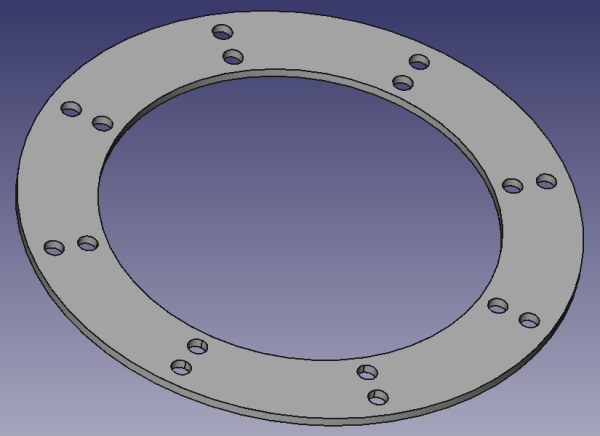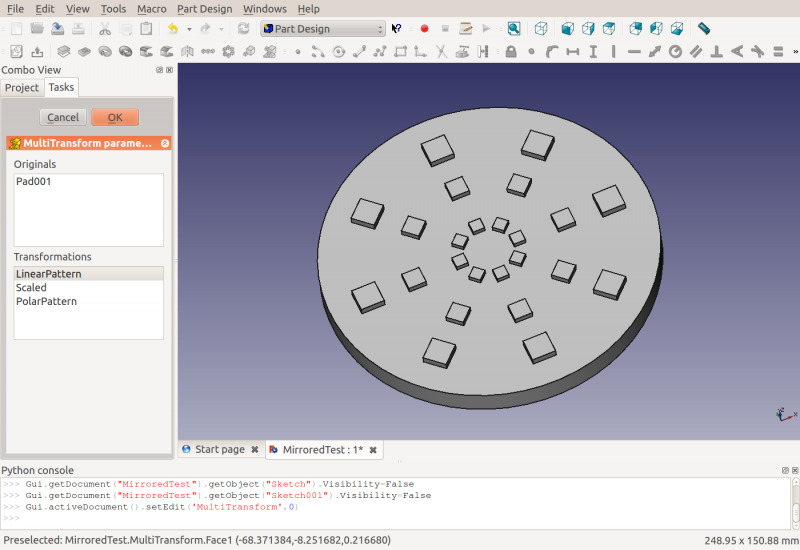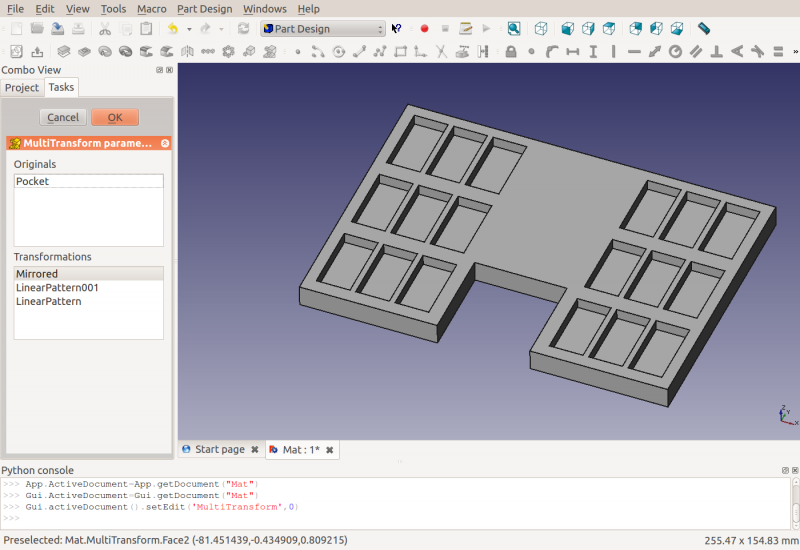PartDesign MultiTransform/de: Difference between revisions
No edit summary |
No edit summary |
||
| Line 86: | Line 86: | ||
* Each transformation linked to the {{Button|[[Image:PartDesign_MultiTransform.svg|16px|link=PartDesign_MultiTransform]] [[PartDesign_MultiTransform| MultiTransform]]}} should use the same feature, or set of features, in each. |
* Each transformation linked to the {{Button|[[Image:PartDesign_MultiTransform.svg|16px|link=PartDesign_MultiTransform]] [[PartDesign_MultiTransform| MultiTransform]]}} should use the same feature, or set of features, in each. |
||
==Begrenzungen== |
|||
<div class="mw-translate-fuzzy"> |
|||
* Eine skalierte Umwandlung sollte nicht die erste in der Liste sein |
|||
==Einschränkungen== |
|||
* |
* Die skalierte Umwandlung muss die gleiche Anzahl von Vorkommen haben wie die Transformation, die ihr in der Liste unmittelbar vorausgeht |
||
* Für weitere Begrenzungen siehe die |
|||
* Die skalierte Transformation muss die gleiche Anzahl von Vorkommen haben wie die Transformation, die ihr in der Liste unmittelbar vorausgeht |
|||
{{Button|[[Image:PartDesign_LinearPattern.svg|20px]] [[PartDesign_LinearPattern|Lineares Muster]]}} |
|||
* Weitere Einschränkungen finden Sie in der |
|||
[[PartDesign_LinearPattern/de|Lineares Muster]] Dokumentation |
|||
{{clear}} |
{{clear}} |
||
</div> |
|||
==Optionen== |
==Optionen== |
||
Revision as of 08:53, 13 August 2020
|
PartDesign MehrfachUmwandlung |
| Menüeintrag |
|---|
| PartDesign -> MehrfachUmwandlung |
| Arbeitsbereich |
| PartDesign |
| Standardtastenkürzel |
| Keiner |
| Eingeführt in Version |
| - |
| Siehe auch |
| Keiner |
Beschreibung
'Ein Muster aus Kombinationen von Umwandlungen herstellen' - Die MehrfachUmwandeln Werkzeug nimmt eine (oder einen Satz von) Part 'Formelementen' als seine Eingabe und ermöglicht es dem Anwender, mehrfache Umwandlungen auf dieses Formelement (oder diesen Satz von Formelementen) zunehmend, der Reihe nach - eine gemeinsame oder zusammengesetzte Umwandlung zu erzeugen.
Zum Beispiel, um den Flansch mit einer doppelten Lochreihe, wie unten abgebildet, herzustellen, der Anwender:
- wählt die Bohrung als 'Formelement' (Basis) im Modellbaum aus
- klickt auf das
MehrfachUmwandlung Symbol
- fügt ein lineares Muster mit zwei Vorkommen in X Richtung hinzu
- fügt ein polares Muster mit acht Vorkommen um die Y Achse hinzu.
Flansch mit doppelter Lochreihe. Lochmuster erstellt mit 'MehrfachUmwandlung' Werkzeug.
Usage
Before beginning any of the methods below, make sure the necessary Body object is active; if not, you will receive a pop-up error message stating you need an active
Body object before using the
MultiTransform tool.
Standard Method
This method starts with no existing transformation features and no selections in the viewport or the Model object tree.
When initiated and completed with this method, the MultiTransform should correctly become the "Tip" of the Body object.
- Click on the
MultiTransform icon to initiate the operation.
- You will be prompted with the Select feature window.
From the list, select one initial feature to be used for the transformations and click OK to proceed.
You may add additional features in the next step.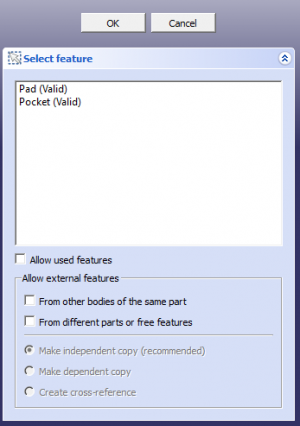
- The Transformed features messages and MultiTransform parameters window will appear.
You will see the label of the feature you selected in the feature list view, below the Add feature and Remove feature buttons.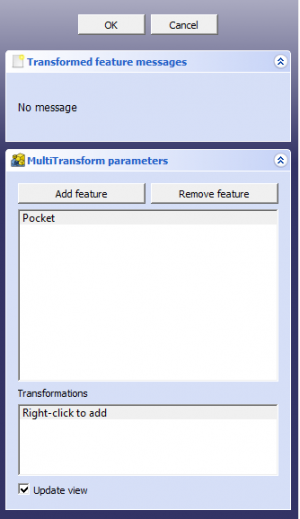
If you want to include additional features for the transformations, follow these instructions:- Click the Add feature button in the transform tool
- Switch to the Model tree view (Click on Model tab)
- Select the feature you want to add, and make it visible(spacebar, or right-click and toggle visibility).
Note: This will hide the previously visible feature. - Click on anything in 3D view (viewport).
- Click on Tasks tab in Combo View to return to MultiTransform parameters window.
- You should see the label of the recently selected feature appear in the feature list view.
- Below the feature list view is the Transformations list view. Within you should see the text, " Right-click to add ".
- Add a transformation by right-clicking in the Transformations list view to display the options list.
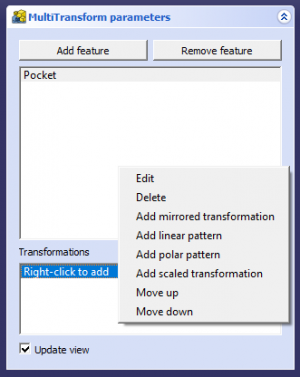
- Add the desired transformation by selecting it in the options list.
- The new transformation entry will appear in the Transformations list with corresponding settings appearing below the list.

- Adjust the settings for the new transformation. (You will see the preview in the viewport.)
- Click the OK button underneath these settings to save the new transformation.
- Continue to add transformations in the order you wish to apply them using Step 5 above.
- You may also edit, delete, and move (change the order of) the transformations as needed by right-clicking on a transformation in the Transformations list and selecting the corresponding option.
- When you are finished adding and editing the transformations, click the OK button at the very top to save the
MultiTransform and exit.
Alternate Method 1
This method starts with one existing transformation feature in the Body object.
- In the Model tree, within the active Body object, select the existing transformation to be included.
- Click on the
MultiTransform icon to initiate the operation.
- In the feature list view, you will see the label(s) of the feature(s) from the existing transformation you included.
To add additional features, see Step 3 in the Standard Method above. - Below the feature list view is the Transformations list view. Within you should see the label for the existing transformation you included.
- Finish using Steps 5-8 in the Standard Method above.
When initiated and completed in this way, the MultiTransform usually fails to become the "Tip" of the Body object. To correct this:
- Right click on the newly created
MultiTransform.
- Choose "Set tip".
Alternate Method 2
This method starts with multiple existing, independent feature transformations in the Body object - with the idea of combining them. NOTE: to combine existing transformations, they must be within the same Body object and should all use the same feature or feature set in each.
- In the Model tree, within the active Body object, select one of existing transformation of those you wish to include.
- Click on the
MultiTransform icon to initiate the operation.
- Click the OK button at top to save and exit.
- In the object tree, select the newly created
MultiTransform.
- In the Property View window, locate the Transformations property in the Data tab.
- Edit the Transformations property by clicking on its value, then click on the ellipse box that appeared to open the Links window for this property.
- Select all existing feature transformations that should be included. Multiple selections are permitted using CTRL + click.
- Click OK to save and close the Links window.
- Click the
Refresh button if activated.
When initiated and completed in this way, the MultiTransform might fail to become the "Tip" of the Body object. If you need it to be the "Tip":
- Right click on the newly created
MultiTransform.
- If available, choose "Set tip".
Usage Notes
- Supported feature transformations are:
Mirrored,
Linear Pattern,
Polar Pattern, and SCALED transformation.
- Each transformation linked to the
MultiTransform should use the same feature, or set of features, in each.
Begrenzungen
- Eine skalierte Umwandlung sollte nicht die erste in der Liste sein
- Die skalierte Umwandlung muss die gleiche Anzahl von Vorkommen haben wie die Transformation, die ihr in der Liste unmittelbar vorausgeht
- Für weitere Begrenzungen siehe die
Optionen
 |
Beim Erstellen eines Mehrfachumwandlungs Formelements bietet der Dialog 'Mehrfachumwandlungs arameter' zwei verschiedene Listenansichten. Originale auswählen=Die Listenansicht zeigt die 'Originale', also die Formelemente, die gemustert werden sollen. Wenn du auf ein beliebiges Formelement klickst, wird es der Liste hinzugefügt. Wähle UmwandlungenDiese Liste kann mit einer Kombination aus den einfachen Umwandlungen gespiegelt, lineares Muster, polar Muster und skaliert gefüllt werden. Die Umwandlungen werden nacheinander angewendet. Das Kontextmenü bietet die folgenden Einträge: BearbeitenErlaubt die Bearbeitung der Parameter einer Umwandlung in der Liste (Doppelklick hat den gleichen Effekt) LöschenEntfernt eine Umwandlung aus der Liste Umwandlung hinzufügenFügt der Liste eine Umwandlung hinzu Nach oben/unten bewegenErlaubt die Änderung der Reihenfolge der Umwandlungen in der Liste |
Beispiele
Das kleinste Polster wurde zunächst dreimal in X Richtung gemustert und dann auf den Faktor zwei skaliert (die drei Vorkommen haben also den Skalierungsfaktor 1,0, 1,5 und 2,0). Dann wurde ein Richtungsmuster mit 8 Vorkommen angewendet.
The pocket was first mirrored on the YZ plane and then patterned with two linear patterns to give a rectangular pattern.
Die Tasche wurde zunächst auf der YZ Ebene gespiegelt und dann mit zwei linearen Mustern gemustert, um ein rechteckiges Muster zu erhalten.
- Struktur-Werkzeuge: Part-Arbeitsbereich, Gruppe
- Part Design-Hilfswerkzeuge: Körper erstellen, Skizze erstellen, Skizze bearbeiten, Skizze einer Fläche zuordnen
- Part Design-Modellierungswerkzeuge
- Datum tools: Bezugspunkt erstellen, Bezugslinie erstellen, Bezugsebene erstellen, Lokales Koordinatensystem erzeugen, Referenzobjekt erstellen, Klon erzeugen
- Additive tools: Aufpolstern (Pad), Rotation, Ausformung, Additives Rohr, Erzeugen eines zusätzlichen geometrischen Körpers
- Subtractive tools: Tasche, Bohrung, Nut, Abziehbarer Loft, Abziehbares Rohr, Erzeuge einen abzuziehenden Grundkörper
- Transformation Werkzeuge: Spiegeln, Lineares Muster, Polares Muster, Create MultiTransform
- Verschönerungswerkzeuge: Verrundung, Fase, Draft-Arbeitsbereich, Dicke
- Boolesche Operationen: Boolesche Operationen
- Extras: Migrieren, Shaft design wizard, Involute gear
- Contextual Menu tools: Spitze festlegen, Move object to other body, Objekt nach einem anderen Objekt verschieben
- Erste Schritte
- Installation: Herunterladen, Windows, Linux, Mac, Zusätzlicher Komponenten, Docker, AppImage, Ubuntu Snap
- Grundlagen: Über FreeCAD, Graphische Oberfläche, Mausbedienung, Auswahlmethoden, Objektname, Programmeinstellungen, Arbeitsbereiche, Dokumentstruktur, Objekteigenschaften, Hilf FreeCAD, Spende
- Hilfe: Tutorien, Video Tutorien
- Arbeitsbereiche: Std Base, Arch, Assembly, CAM, Draft, FEM, Inspection, Mesh, OpenSCAD, Part, PartDesign, Points, Reverse Engineering, Robot, Sketcher, Spreadsheet, Surface, TechDraw, Test Framework
